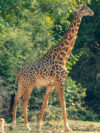Wild Dog Research and Conservation in Luambe National Park
Tags: Research, Zambia
Implementing Partners: Zambian Carnivore Programme
Luambe’s Wild Dogs
The African wild dog is one of Africa’s most endangered predatory species. The current range is around 7% of the original range. The IUCN Red List categorises the species as critically endangered (1). The IUCN/SSC Canid Specialist Group estimates a total population of 6,600 animals in 39 populations, but only 1,400 of these are adult dogs that also reproduce. This is due to the complex biology of the species, as only the alpha male and the alpha female per pack reproduce and are supported by the other pack members (2).
The causes of population collapse are habitat fragmentation, human persecution, and the spread of animal diseases (4).
The African wild dog is a species that has huge foraging areas and occurs at low densities. A pack’s home range can cover thousands of square kilometers. Today’s occurrences are for this reason on largely pristine landscapes with intact habitat and low human pesence. Wild dogs have disappeared from over 90% of their original range as a result and are now found in only 14 African states (3, 4). Only six of these states, which include Zambia, have viable populations (5).
The Luangwa Valley is home to the largest wild dog population in Zambia, alongside the Greater Kafue Ecosystem. C4C works closely with the Zambian Carnivore Programme (ZCP) and regularly supports research activities in the Luangwa Valley.
In 2019, ZCP continued Zambia’s longest running wild dog monitoring project in the Luangwa Valley. This includes continued work in and around South Luangwa National Park, as well as continued and expanded work in Luambe National Park, North Luangwa National Park and adjacent Game Management Areas (GMAs).
ZCP was able to identify 195 wild dogs in 18 packs and dispersed groups spread over an area of about 12,000 km². The “Carnivore” research team devoted intensive monitoring to 14 resident packs.
The pack named “Chikwinda Pack”, which is regularly seen in Luambe, originally comes from the Nsefu Sector in South Luangwa National Park, about 60 km south of Luambe National Park. After settling in the southern part of Luambe National Park in 2019 and raising seven cubs, the pack moved further into the buffer zone between Luambe’s southern boundary and the Lukusuzi River in 2020. Two adults were able to be fitted with satellite tracking collars in October 2020, thanks to funds provided by C4C. Cubs were successfully reared again in 2021. The pack size was 24 animals in 2021.
Now it remains to be seen where the pack will move in the future. The collars enable the researchers to find the animals at any time and to check the condition of the pack or whether individual animals have been snared by poachers. This methodology is essential for the long-term protection of the wild dog population in the Luangwa Valley.
- https://www.iucnredlist.org/species/12436/166502262
- https://www.canids.org/species/view/PREKNU724601
- http://www.cheetahandwilddog.org/wild-dog/
- https://www.researchgate.net/publication/311535789_Genome_sequence_population_history_and_pelage_genetics_of_the_endangered_African_wild_dog_Lycaon_pictus**
- https://www.zambiacarnivores.org/science
- https://static1.squarespace.com/static/591343e103596e24bb42647b/t/60f51908689a653fd2ac9345/1626675731542/ZCP+2020+Annual+Report-compressed_1.pdf



